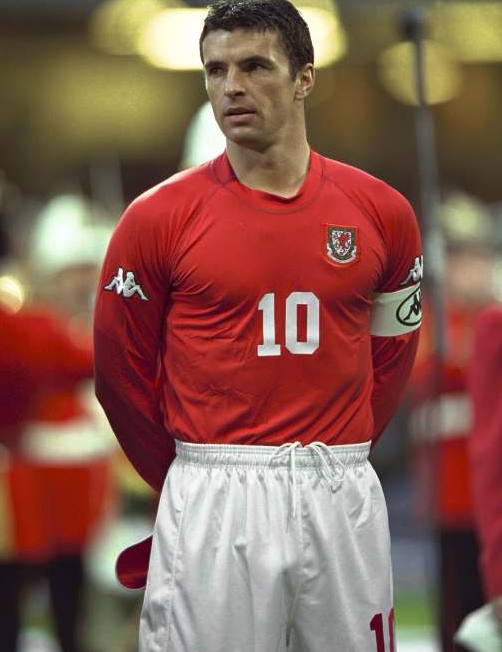Full backs…to the future!
Leon Barton Leon analyses the evolution of Wales full back options since the 1990s and early 2000s, when players would often be press-ganged into playing out of position to mask our deficiencies in quality. In contrast, today the full back position is arguably where Wales has the greatest depth and potential.
Full back is not the most glamorous position. ‘Full backs are either failed wingers or failed centre halves’ as Jamie Carragher stated on Monday Night Football. ‘No-one wants to be a full back as a kid… no-one wants to grow up and be Gary Neville’ he went on, turning to his co-pundit with a knowing chuckle.
As someone who used to play that position in junior football, I’ve heard the jokes about being ‘left back’ in the changing room. The role of the full back used to be so reductive. In the late 80s and early 90s my job was basically to stop the opposition winger – get tackles in, take throw ins and – pre-the backpass rule – pass the ball back to the keeper from goal kicks so he could pick it up and kick it (further) out of his hands. Which seems utterly absurd now but that’s how backward British football was at the time.
I preferred to play in central midfield, fancying myself as a budding Glenn Hoddle. Sadly, nobody else did, certainly not our coach, who would only play me there if one of our first choice centre mids was missing through illness/injury/hangover/demanding girlfriend/it’s a bit cold out. I remember grabbing a few goals in my final season before being claimed by cider and grunge. We’re going back nearly thirty years, but my memory is that I got to play in midfield in those games, whereas, when playing full back I never came close to scoring because I was told to never go beyond the halfway line. Seriously.
It would be another 15 years or so before I played organised football again; 7-a-side in a Thursday night league when I lived in Cambridge. We tended to play the 3-2-1 formation (we called it ‘the Dusty Bin’ system…80s kids will get that reference) I was on the right or left of the 3 at the back. I absolutely loved playing that role, especially the onus to attack. Yes, we were reliant on our one centre back to hold the fort if moves broke down, but provided we did plenty of running, that system usually worked. Our team even won a trophy in 2008/9, something that eluded me in junior football! And I used to find the net on a regular basis.
I was like a right-footed version of the young Gareth Bale (at that time a wing back on the international stage). Except without the pace. And strength. And skill….
But other than that I was just like him. But that’s enough about me, lets talk proper football.
As with much about Wales’s recent success, the roots of the extra emphasis on full backs/wing backs attacking can be traced back to Brian Flynn’s superb under 21 team of 2007-2012 (he took the role in early 2005, but it took a little while for the results to come). He played with 4 at the back, not 5, but was always keen for his full backs to get forward. ‘Modern day playmakers’ he called them. During the youngsters’ 2-1 victory over Italy at Swansea’s Liberty Stadium in 2009 he even played a 4-2-2-2 system which was wholly reliant on the full backs – Neil Taylor and Neal Eardley – providing the width during attacking phases of play. Both had superb games.
This was part of a process, overseen by John Toshack, whereby Welsh international football gained a degree of sophistication not previously seen before. Put succinctly: what Toshack did during his six year stint was turn Wales from a British team into a European one. The broadening of the defenders’ remit was part of this process.

While I think the criticisms of Toshack’s methods – of which there have been many (just listen to the EJFOF episodes with players of that era to hear them) – are entirely valid, footballers tend to be quite self-absorbed. It’s not on their radar to see the bigger picture in the way us long-suffering fans perhaps can.
Toshack had spent two decades on the continent by the time he became Wales manager at the end of 2004 and of course being so steeped in European methodology clearly influenced his approach with Wales. The difference in the 90s was pretty stark, with Middlesbrough’s Italian striker Fabrizio Ravanelli stating in 1997 that ‘the English have tons of money but they lack the organisation of Italian soccer’.
Would Wales’s increased levels of of tactical and athletic sophistication have occurred anyway due to foreign influence on the Premier League? Perhaps, but I remain convinced that Toshack’s tenure sped the process up. Which is possibly why it’s taken football-mad Scotland until the 2020’s to catch up…
Roy Keane, in his first autobiography, talked of Manchester United’s pre-1999 struggles in the Champions league, where, despite dominating domestically, they would flounder when up against:
Tough, wily defenders, guys nobody had ever heard of, who closed space down, timed their tackles to perfection, were instinctively in the right cover positions, had pace and read the game superbly.
Keane also went on to say that although Eric Cantona was a ‘magical asset at home. A match winner countless times in the Premier League and FA Cup [but] he didn’t come close to making the same impact in Europe; ‘I can’t recall one important European game that he turned for us’. Which just shows how great the gap was at the time.
Perhaps it’s also why past-their-best Italian strikers like Gianluca Vialli were still able to tear it up in the Premier league. Although slower and creakier than in his prime, Vialli still enjoyed a few field days against defenders who conspicuously lacked the nous, cunning and positional sense of those he was used to facing in Serie A. Ravenelli, again, subtly mocked the game here:
for explosiveness and reaction time [British players] can’t match the Italians. In soccer you have to do more than run
By the time of Mark Delaney’s debut in late 1999, Wales had not had a single international quality full back – on either side – for a couple of years. Mark Bowen, whose final cap came in 1997, was probably the last one and in between them ‘orthodox’ full backs such as Steve Jenkins, Darren Barnard, Andy Legg, and Rob Edwards (the Preston one, not the Villa/Wolves one), played in the position. Or the likes of John Robinson and Mark Pembridge were asked to play in the unfamiliar into the role and clearly were both more comfortable in midfield.

But even during Bowen’s (and Paul Bodin’s) era, the lack of options, let alone quality, in the position was clear. If they were unavailable, like Robinson and the ‘Merthyr Maradona’, midfielders such as David Phillips and Clayton Blackmore were asked by manager Terry Yorath to fill in at full back.
Those two, with decent levels of top flight experience under their belt, could at least cope with the task. Which is more than can be said for Portsmouth reserve Gavin Maguire. His performance at right back against Germany in 1991 was the stuff of nightmares; 45 minutes of out-of-his-depth floundering before being hauled off at half time. He did at least provide a pinpoint assist. But sadly, that was for German striker Rudi Völler to nod in an easy second goal for the home side.
As welcome as Delaney’s emergence was following his move to Aston Villa (a Welsh defender with pace? Christ, will these miracles never cease!) he was arguably something of an outlier for the next few years. The left side was to remain a problem. It seemed manager Mark Hughes may have hit upon a solution when he moved his best central defender Chris Coleman to left back (where he had played many times in his early days at Swansea City), allowing Andy Melville and Rob Page to pair up in the centre, bringing quality to each constituent part of the defence. A highly creditable 0-0 draw in Poland in October 2000 brought a first competitive clean sheet for four years but, sadly, Coleman crashed his car into a tree a few weeks later and it was back to the drawing board.

The issue was one Hughes was so desperate to fix that he then decided his best central midfielder and captain would have to play left back instead. Gary Speed did a fine job but it was clear that he was simply filling in until a better solution could be found. Similarly, Danny Gabbidon, who had had club experience at right back, made his Wales debut in a 2002 friendly against the Czech Republic at left back.
Former England U21 star Ben Thatcher declared for Wales in 2004 but his seven cap international career was as brief as it was bad. Danny Collins rivalled Maguire for ineptitude with his performance against Cyprus in 2005 (at least, in Maguire’s defence, the Germans were world champions). While Richard Duffy disappeared as quickly as he emerged, and Rhys Weston, converted from a centre back, largely laboured in his seven caps. Sam Ricketts offered versatility by playing on both flanks and was a good servant for Wales, but these were all much of a muchness.
It is often forgotten that Mark Delaney (now under 23 coach at Aston Villa) played in the opening qualifier for the 2008 World Cup against the Czech Republic (it seems incongruous that Delaney and Lewin Nyatanga figured in the same back line for games). Toshack appreciated his qualities but the chronic injury problems had diminished his athleticism and pace.
It probably took until the 2011/12 season, when 22 year old Neil Taylor became a Premier League player with Swansea City, for some sort of long term solution to the left back problem that had plagued Wales for fifteen years to finally be resolved.
But back in the 90s and 00s the almost inevitable result was that intelligent international teams would work out our weak links (which was very often full back) and target them without mercy. It’s a far cry from where we find ourselves today. In fact, I don’t think any other position on the pitch illustrates the contrast between the Wales of old, and the Wales of ‘now’ like full back.
Conor Roberts and Neco Williams are not mistake proof. Neither are infallible – we’ve seen errors from both. But we’ve also seen a dynamism that I’m not sure I’ve witnessed before from any Welsh full/wing backs working in tandem.
Roberts, a footballer for whom the word ‘ebullient’ could have been invented, has an appetite for running that only appears to be matched by his love of carpentry. ‘It baffles me when, after a few games, players say they need to rest for weeks’ he told The Guardian‘s Ben Fisher.
You only get a certain amount of time on this planet and in football, so rack up as many minutes, as many goals, as many assists and as many good performances as you can and when it is all said and done you can look back and have no regrets.
connor roberts
His attitude to application even seems to baffle some of his teammates. ‘Some of the boys do say to me “it’s mad you play every game, and in the 90th minute you’re trying to make the opposition box, and then you go home and spend three hours hammering in stuff in the workshop.”
A quick peek at twitter or the fan message boards after the 1-1 draw against Belgium last time out revealed straight away how excited Wales are about the emergence of Neco Williams. There’s also been talk that maybe he’ll end up as a winger or midfielder. But, for now, playing on the left, cutting in and getting shots away on his stronger right foot seems to suit both him and Wales. Especially as he usually has the defence-duty conscious Daniel James ahead of him down that flank.
“When I was going through the ranks I’ve always been a winger, so I’ve always had that attacking scenario in my mind and my play’ he told Liverpool’s official website”
That’s been clear for Wales, with two goals international goals already and only a fine save from Koen Casteels preventing him smashing home a memorable third last time out versus Belgium. Although yet to find the net for the Liverpool first team, he has racked up a number of assists, something he attributes to countless hours of repetition and drills on the training pitch.
It’s an attitude he’s taken into learning the craft of defending upon being moved to right back at around the age of 16;
When I’m training obviously I’m trying to focus on myself and my own game but at the same time, I’m watching Trent [Alexander-Arnold] and trying to study how he plays.
Chris Gunter won several penalties for Wales by driving into the box and in the Euro 2016 quarter final provided surely the most famous assist in the history of Welsh football . “Don’t cross that fucking ball Christopher” and all that. Neil Taylor’s goal versus Russia at the group stage was a deliriously memorable moment. But that’s the only time either netted for Wales in 149 caps (so far). For contrast, Connor and Neco already have five between them in 51.
‘Remember Sorba Thomas?’ quipped Russell in episode 126 after we’d praised the performances of Roberts and Williams after the Belarus and Belgium games. But you need options, and his ability to play on the left or right, provide regular assists and defend his flank, surely makes him third choice in the position of wingback. Thomas has only just turned 23, so if Neco Williams does eventually move further up the pitch (à la Bale) then he could yet establish himself as a first choice player for Wales. 22 year old Rhys Norrington-Davies has also impressed in his six caps so far. And we haven’t even mentioned another Liverpool youngster in highly-rated 19 year old right back Owen Beck who looks like the next likely graduate from the u21s.
It might even be argued that, in terms of depth at least, full back/wing back has gone from being our weakest position at the turn of the millennium to our strongest two decades on. The success of the team since 2015 has been joyous but I’m looking forward to what the next few years bring because, in all likelihood, there’s more to come.
Or, in the immortal words of Dr. Emmett Brown:
Your future is whatever you make it. So make it a good one




























